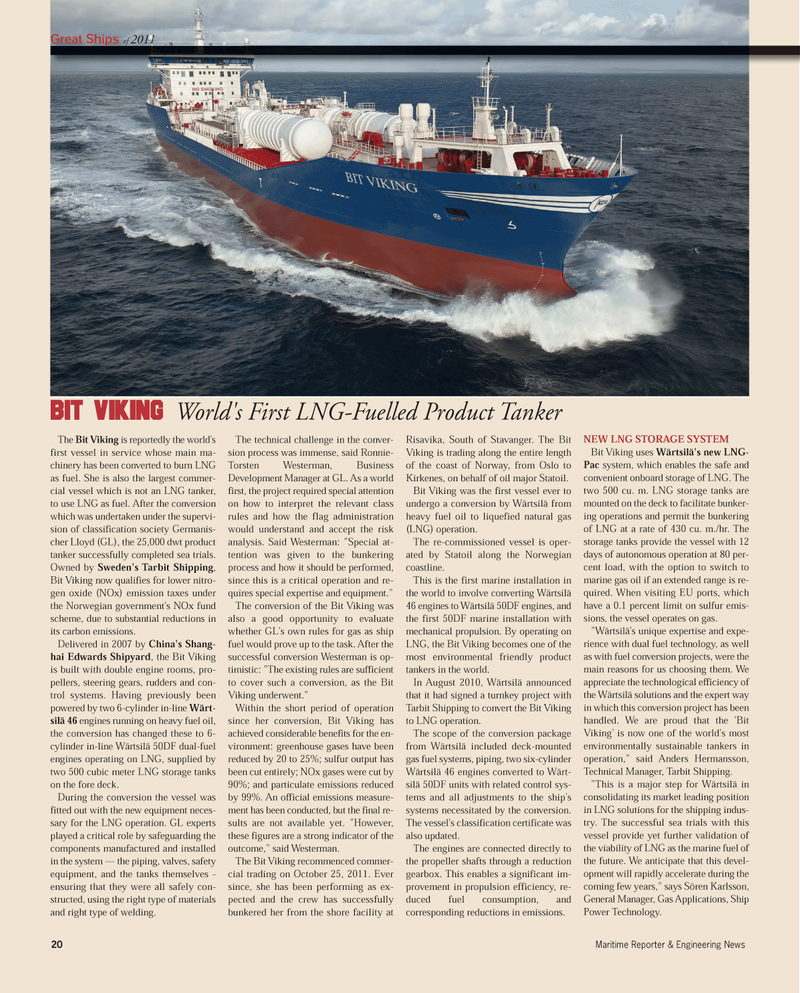
Page 20: of Maritime Reporter Magazine (December 2011)
Great Ships of 2011
Read this page in Pdf, Flash or Html5 edition of December 2011 Maritime Reporter Magazine
20Maritime Reporter & Engineering News TheBit Viking is reportedly the world's first vessel in service whose main ma- chinery has been converted to burn LNG as fuel. She is also the largest commer- cial vessel which is not an LNG tanker, to use LNG as fuel. After the conversion which was undertaken under the supervi- sion of classification society Germanis- cher Lloyd (GL), the 25,000 dwt product tanker successfully completed sea trials. Owned by Sweden's Tarbit Shipping ,Bit Viking now qualifies for lower nitro- gen oxide (NOx) emission taxes under the Norwegian government's NOx fund scheme, due to substantial reductions inits carbon emissions.Delivered in 2007 by China's Shang-hai Edwards Shipyard , the Bit Viking is built with double engine rooms, pro- pellers, steering gears, rudders and con-trol systems. Having previously been powered by two 6-cylinder in-line Wärt-silä 46 engines running on heavy fuel oil, the conversion has changed these to 6- cylinder in-line Wärtsilä 50DF dual-fuel engines operating on LNG, supplied bytwo 500 cubic meter LNG storage tanks on the fore deck.During the conversion the vessel was fitted out with the new equipment neces- sary for the LNG operation. GL experts played a critical role by safeguarding the components manufactured and installed in the system ? the piping, valves, safety equipment, and the tanks themselves - ensuring that they were all safely con- structed, using the right type of materialsand right type of welding.The technical challenge in the conver- sion process was immense, said Ronnie- Torsten Westerman, Business Development Manager at GL. As a world first, the project required special attention on how to interpret the relevant class rules and how the flag administration would understand and accept the risk analysis. Said Westerman: "Special at- tention was given to the bunkering process and how it should be performed, since this is a critical operation and re-quires special expertise and equipment." The conversion of the Bit Viking was also a good opportunity to evaluate whether GL's own rules for gas as ship fuel would prove up to the task. After the successful conversion Westerman is op- timistic: "The existing rules are sufficient to cover such a conversion, as the Bit Viking underwent." Within the short period of operation since her conversion, Bit Viking has achieved considerable benefits for the en- vironment: greenhouse gases have been reduced by 20 to 25%; sulfur output hasbeen cut entirely; NOx gases were cut by 90%; and particulate emissions reducedby 99%. An official emissions measure- ment has been conducted, but the final re- sults are not available yet. "However, these figures are a strong indicator of the outcome," said Westerman. The Bit Viking recommenced commer- cial trading on October 25, 2011. Ever since, she has been performing as ex- pected and the crew has successfully bunkered her from the shore facility at Risavika, South of Stavanger. The Bit Viking is trading along the entire length of the coast of Norway, from Oslo to Kirkenes, on behalf of oil major Statoil. Bit Viking was the first vessel ever to undergo a conversion by Wärtsilä from heavy fuel oil to liquefied natural gas (LNG) operation. The re-commissioned vessel is oper- ated by Statoil along the Norwegian coastline.This is the first marine installation in the world to involve converting Wärtsilä 46 engines to Wärtsilä 50DF engines, and the first 50DF marine installation with mechanical propulsion. By operating onLNG, the Bit Viking becomes one of the most environmental friendly product tankers in the world. In August 2010, Wärtsilä announced that it had signed a turnkey project with Tarbit Shipping to convert the Bit Viking to LNG operation. The scope of the conversion package from Wärtsilä included deck-mounted gas fuel systems, piping, two six-cylinder Wärtsilä 46 engines converted to Wärt- silä 50DF units with related control sys-tems and all adjustments to the ship'ssystems necessitated by the conversion. The vessel's classification certificate was also updated. The engines are connected directly tothe propeller shafts through a reductiongearbox. This enables a significant im- provement in propulsion efficiency, re- duced fuel consumption, andcorresponding reductions in emissions. NEW LNG STORAGE SYSTEM Bit Viking uses Wärtsilä's new LNG-Pac system, which enables the safe andconvenient onboard storage of LNG. The two 500 cu. m. LNG storage tanks are mounted on the deck to facilitate bunker- ing operations and permit the bunkering of LNG at a rate of 430 cu. m./hr. The storage tanks provide the vessel with 12 days of autonomous operation at 80 per- cent load, with the option to switch tomarine gas oil if an extended range is re- quired. When visiting EU ports, which have a 0.1 percent limit on sulfur emis- sions, the vessel operates on gas. "Wärtsilä's unique expertise and expe- rience with dual fuel technology, as well as with fuel conversion projects, were the main reasons for us choosing them. We appreciate the technological efficiency of the Wärtsilä solutions and the expert way in which this conversion project has been handled. We are proud that the 'Bit Viking' is now one of the world's most environmentally sustainable tankers in operation," said Anders Hermansson, Technical Manager, Tarbit Shipping. "This is a major step for Wärtsilä in consolidating its market leading position in LNG solutions for the shipping indus-try. The successful sea trials with this vessel provide yet further validation of the viability of LNG as the marine fuel ofthe future. We anticipate that this devel- opment will rapidly accelerate during thecoming few years," says Sören Karlsson, General Manager, Gas Applications, Ship Power Technology. Great Shipsof 2011Bit VikingWorld's First LNG-Fuelled Product Tanker MR Dec.11 # 3 (18-24):MR Template 12/6/2011 9:37 AM Page 20

 19
19

 21
21
